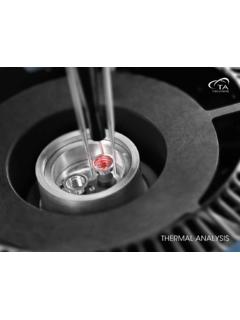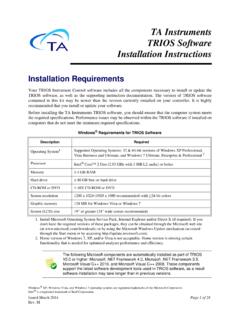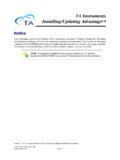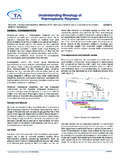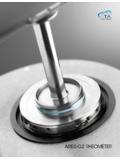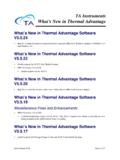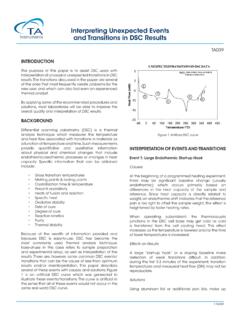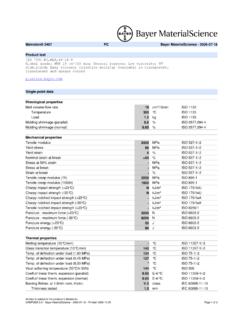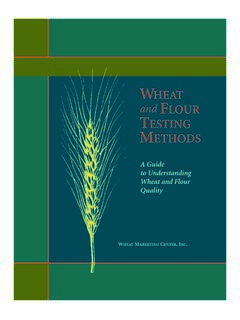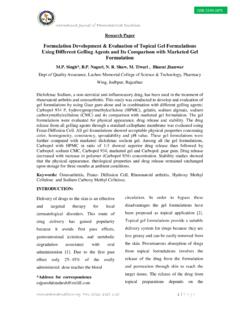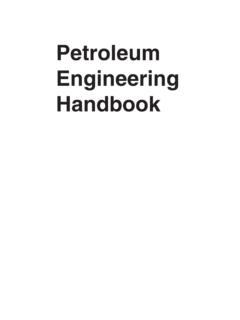Transcription of Understanding Rheology of Structured Fluids
1 Understanding Rheology of Structured Fluids Keywords: Structured Fluids , sol gel transition, solution, yield stress, thixotropy, viscosity, mechanical stability, AAN016. shelf life, flow curve, inks, cosmetics, dispersions, food GENERAL CONSIDERATIONS. Fluids : Simple or Structured Fluid materials, by definition, are systems which flow when subjected to stress. How they respond to an input stress is the heart of rheological testing and may be a complex issue. There are many types of Fluids : pure substances, mixtures, dispersions and solutions, falling into the categories of either simple or Structured Fluids . Each has its own unique behavior when subjected to stress. In general, when a material has a uniform phase, such as a solution or pure substance, it is referred to as a simple fluid.
2 Materials which contain more than one phase, such as solid particles dispersed in a liquid, gas particles in foam or an emulsion of immiscible liquids are considered Structured Fluids since their rheological behavior is in general dominated by the interactions of the constituents. Figure 1: Viscosity of a Structured fluid as a function of shear rate and particle concentration1. Structured Fluids Many of the materials we use each day are Structured Fluids . Nearly all these materials have a viscosity that drops at higher Most foods, cosmetics, pharmaceuticals and paints contain rates of shear velocity resp, stress. This is the phenomenon of particles or droplets of an immiscible fluid suspended in a shear thinning which becomes progressively larger as the carrier liquid.
3 A number of soft semisolid materials also fall volume concentration of solid particles increases. At high under the category of Structured Fluids since they have a concentration of solid content, the low shear rate viscosity multiphase structure and exhibit complex flow behavior. region disappears completely, the material is yielding. Some examples would be cheeses, lipstick, caulk, and bread Some materials show after the shear thinning region with dough. increasing rate or stress, an increase of the viscosity, usually due to structure rearrangements as a result of the applied Many factors affect the stability of Structured Fluids . The shear. This is referred to as flow induced shear thickening.
4 Viscosity of the liquid phase in dispersions usually plays an important role on the flow properties of the material. Characteristic flow parameters and functions Dispersions have wide variations in performance depending on particle size, shape, concentration, and any attraction Bingham Flow with the continuous phase in which they are suspended. Eugene Bingham, a colloid chemist, first coined the term When there is a repulsive electrostatic or steric force between Rheology . He also showed that for many real Fluids a particles they end not to settle rapidly, instead forming critical level of stress must be attained in order to initiate a network structure which will stabilize the suspension if flow.
5 Below this critical stress, y, the material behaves as a undisturbed. Shearing or even Brownian motion can destroy solid, absorbing the stress energy without flowing. Once the this delicate structure and break down the Fluids viscosity. threshold of critical stress has been reached, the material yields to flow, hence the term, yield yield stress is the Structured Fluids do not obey a simple linear relationship reason, why you need to shake or tap a bottle to make the between applied stress and flow (Newtonian fluid behavior) ketchup flow. Materials which exhibit Newtonian flow beyond as shown in Figure 1 for suspensions of latex particles with the yield bear the name Bingham Fluids .
6 Increasing volume fraction in water. Plastic Flow Most materials do not exhibit Newtonian flow after the yield, but have a viscosity that decreases (shear thinning) until a plateau is reached. Lipsticks, drilling muds and toothpaste are good examples of shear thinning non-Newtonian materials 1 AAN016. with a yield stress. Pseudoplasticity Some materials do not have a yield stress, nevertheless they behave nonlinear. These are considered pseudoplastic. They flow instantaneously upon application of stress but also display shear thinning behavior. Polymer solutions exhibit pseudoplastic flow as does bread dough and many paints and cosmetics. A plot of viscosity versus shear rate for different types of materials is shown in Figure 2.
7 Figure 3: Structure build up after previous shear monitored with small strain amplitude oscillatory testing The viscosity of thixotropic materials does not follow the same path on structure breakdown and recovery. In most cases, when the shear rate is slowed, the stress path lags forming a hysteresis loop, which then returns to a point lower than the Figure 2: Viscosity versus shear rate for different types of material initial critical shear stress. The area within the hysteresis loop represents the energy consumed in structure breakdown (Figure 4). Dilatancy Dilatancy, also known as shear thickening, is an unusual phenomenon whereby materials actually increase their viscosity upon stirring or shearing.
8 In some cases these are dense suspensions of solid particles in a fluid medium, which develop greater spacing between particles during agitation. This behavior is infamous in quicksand, moist beach sand and certain pharmaceuticals such as a suspension of penicillin. Shear thickening often result from material instability and structure rearrangements or phase separation. Thixotropy For many fluid materials, viscosity is mostly independent of time, and is only a function of the shear rate and temperature. For concentrated dispersions their viscosity does not reach a steady value for some time upon application of stress, or shear rate. This steady state is dependant on the stabilization Figure 4: Hysteresis loop of a thixotropic material of internal network structures that can be broken down by shearing, and require time to rebuild.
9 A steady state plateau in viscosity is reached if an equilibrium has been established Rheopexy between structure breakdown and rebuilding. Upon ceasing Whereas a thixotropic fluid's viscosity decreases over time the shear rate which caused the breakdown, the material under an imposed constant shear rate, a rheopectic fluid's reforms its internal network, and the viscosity recovers (Figure viscosity increases under an imposed shearing action. 3). The term used to describe this phenomenon is Thixotropy. A rheopectic fluid such as a dense suspension of latex In studying such materials it can be beneficial to destroy the particals or plastisols will gel when agitated. If allowed to network structure entirely by shearing the material, giving a rest, a rheopectic fluid will return to its original lower viscosity.
10 Clean-slate for examination of the path by which the viscosity The viscosity-shear rate curve forms a hysteresis loop and rebuilds. the hysteresis can be repeated indefinitely. This is a way to distinguish between true and apparent rheopectic behavior - Fluids that change physically or chemically (gelling, solvent evaporation) while a shear is imposed also experience a viscosity increase. These changes, however, will not be 1. Laun, M. Private communication 1964 2 AAN016. reversible and therefore do not represent true rheopexy. rest behaves viscoelastic and the time dependent stress or viscosity build-up competes with the viscosity decrease due Time Dependency- Creep and Creep Recovery to structure break-down with increasing stress.
